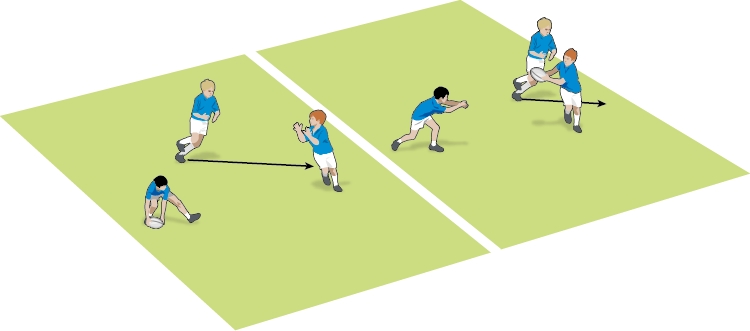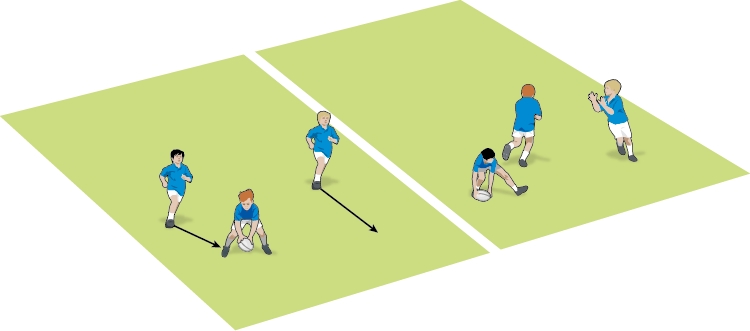You are viewing
1 of your 2 free articles
Super-fast clearance (scrum half) passes
Passing and Handlingby Dan Cottrell
With younger age groups, the ball must be passed away from either the tackle or the ruck. Every player needs to be a clearing passer, and the faster the better.
The clearance pass doesn’t need to be a spin pass. A firm pass, with the hands going through to the target is enough on most occasions. All the players in your team should be practising this skill.



The clearance pass doesn’t need to be a spin pass. A firm pass, with the hands going through to the target is enough on most occasions. All the players in your team should be practising this skill.
ACTIVITY

- Have one player as the clearing passer, and two players as receivers.
- The clearing passer starts at the ball, with the first receiver about 5m away to the side and the other receiver right behind the clearing passer.

- The clearer passes to the first receiver as they run onto the ball.
- The receiver then runs forward a couple of paces and puts the ball down.
- The other receiver runs around into position, with the clearer runs to the ball on the ground. The group then repeats.
DEVELOPMENT
- Once the ball is placed, the next receiver can choose to go left or right, but with a clear call first.
GAME SITUATION

- Three lettered players stand about 7m from a try line with a ball about 2m from the try line.
- Shout out a letter and that player is the clearing passer. The others are the receivers.
- The group has to score in the quickest possible time, with a clearing pass and one more pass.
- Race more than one group at a time.
TECHNIQUE
- Sit over the ball to pass.
- Throw the hands towards the target.
- Run onto the pass.
Related Files
Vol-1-Issue-488-D-Cottrell-super-fast-clearance-scrum-half-passes.pdfPDF, 618 KB
Newsletter Sign Up
Coaches Testimonials

Gerald Kearney, Downtown Las Vegas Soccer Club

Paul Butler, Florida, USA

Rick Shields, Springboro, USA

Tony Green, Pierrefonds Titans, Quebec, Canada
Subscribe Today
Be a more effective, more successful rugby coach
In a recent survey 89% of subscribers said Rugby Coach Weekly makes them more confident, 91% said Rugby Coach Weekly makes them a more effective coach and 93% said Rugby Coach Weekly makes them more inspired.
Get Weekly Inspiration
All the latest techniques and approaches
Rugby Coach Weekly offers proven and easy to use rugby drills, coaching sessions, practice plans, small-sided games, warm-ups, training tips and advice.
We've been at the cutting edge of rugby coaching since we launched in 2005, creating resources for the grassroots youth coach, following best practice from around the world and insights from the professional game.
More from us
© 2023 Rugby Coach Weekly
Part of Green Star Media Ltd. Company number: 3008779
We use cookies so we can provide you with the best online experience. By continuing to browse this site you are agreeing to our use of cookies. Click on the banner to find out more.













